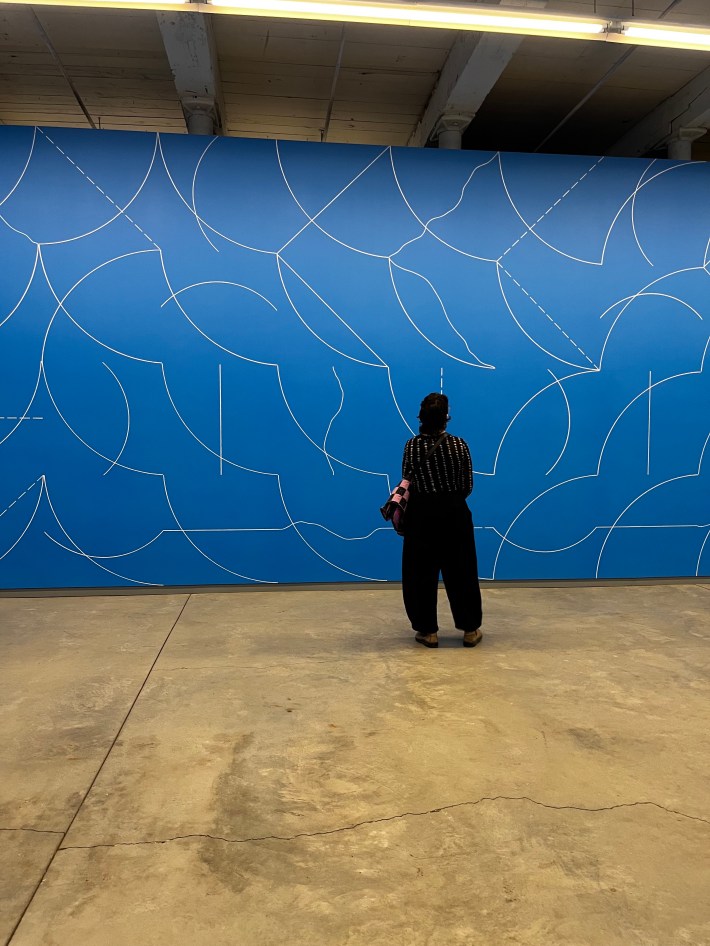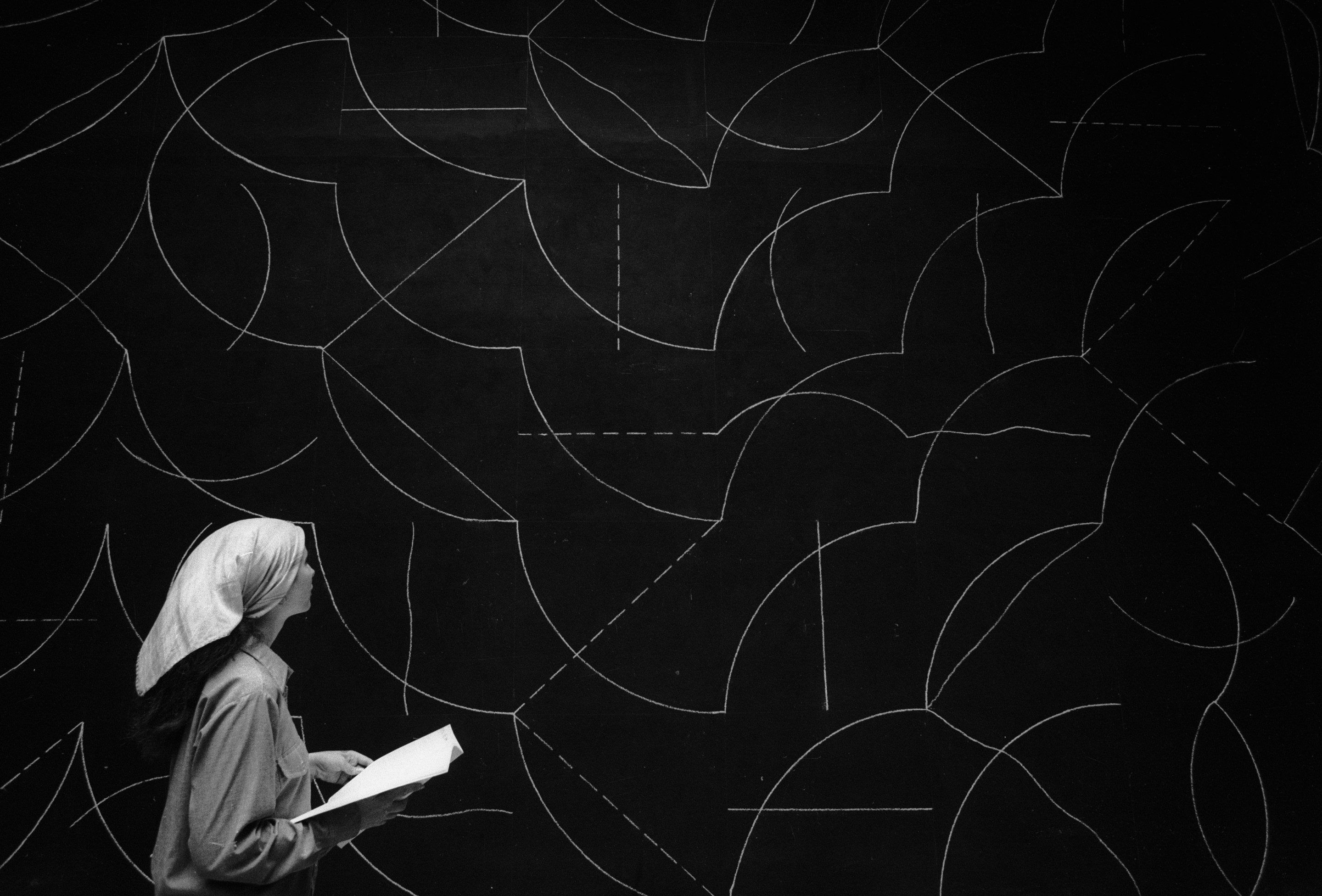Standing in front of Sol LeWitt’s Wall Drawings, I felt my body go all fuzzy. My eyes followed the precise lines that crossed each other again and again, each on its own predetermined path but also existing as a component of the whole. Humble straight lines drawn in pencil or crayon, multiplied to such a dizzying degree that when you stand back, they blend together into a wiggling mass that comes into and out of focus like an optical illusion. I wanted to run my fingers over the lines; I imagined I would be able to feel the ridges they made in the wall, the way my handwriting does in my notebooks.
It was the last day of summer, and I was visiting Mass MoCA for the first time with a group of my former coworkers. It’s been seven years since we all worked together, and in that time our relationships have cohered more into a family. There were 10 of us there that day, plus two babies, so once we started looking at the art, we broke up into groups based on our pace, interests, and whether we had a toddler to chase.
I wandered into Building 7 with my friend Eleanor, which housed a retrospective of Sol LeWitt’s wall drawings across three floors.
“I think Sol LeWitt is the first time I realized that artists don’t always make their own art,” she said as we entered the exhibit. Plenty of artists don’t literally make their own work. This was true of the great Renaissance painters, and it’s true of contemporary artists as well. Despite being fabricated by dozens of anonymous hands, these major pieces only bear the names of the artists at the top.
Some of LeWitt’s pieces, like Wall Drawing 237, include text instructions for the drafters who are intended to recreate it: “The location of a trapezoid. A trapezoid whose top side is half as long as its bottom side and whose left side is one and half times as long as the top side and is located where a line drawn from a point halfway between a point halfway between the center of the wall and the upper left corner and a point halfway between the midpoint of the top side and the upper left corner …” (This goes on for a while.) The directions for reproduction are built into the work itself, which puts the artist’s intentions into direct conversation with the hands that make them a reality. LeWitt died in 2007, and I’m aware of his ghostly presence among the marks, too. His instructions transcend time and viewing these pieces becomes a conversation between the viewer, LeWitt, and the drafters who actually drew those lines.
I began to wonder about the drafters. I stared straight at the lines and imagined the precision it took to execute them; have you ever tried to draw two straight lines with a ruler? Now imagine drawing hundreds of them for a piece whose efficacy relies on absolute perfection of the line. It’s staggering to look at a piece like Wall Drawing 19 and not think of the hands that made it.
Still, the works themselves are evidence that the drafters were there. LeWitt seems to have imagined the idiosyncrasies of new drafters’ interpretations from the beginning; in "Doing Wall Drawings," he wrote “each person draws a line differently and each person understands words differently.” The art, then, exists not in a perfect adherence to LeWitt’s geometric direction, but in the remediation that takes place as drafters recreate the pieces in each new mounting. The art is the idea, and the art is the execution.

In his essay “Paragraphs on Conceptual Art,” LeWitt defines conceptual art as work in which “all of the planning and decisions are made beforehand and the execution is a perfunctory affair. The idea becomes a machine that makes the art.” He goes on to say, “It is usually free from the dependence on the skill of the artist as a craftsman,” because in conceptual art, it is the idea that takes precedence over the execution. In LeWitt’s paradigm, then, the drafters who execute his wall drawings are tools in the artist’s creative process; they're another medium, like paint or ink, for expressing the idea at the center of the work.
LeWitt was still interested in the distinctions each person brought to adapting his work. One piece I can’t stop thinking about is Wall Drawing 797, a wavy, crinkling wall of red, yellow, and blue marker lines that looks a bit like a topographical map or a seismogram. LeWitt instructed a drafter to draw a single, irregular horizontal line across the wall as high as they could reach. Then, another drafter copied the line directly underneath it in a different color. This continued all the way down the wall, resulting in a gentle evolution that distorted the original bumps and curves into sharper and duller shapes. It’s a visual game of telephone, and it explicitly acknowledges the presence of the multiple drafters’ subjectivity. It only works because of the unpredictably human quirks each of the drafters brought to this deeply unemotional task of copying a marker line.
Mass MoCA’s page for Wall Drawing 797 lists the names of the original four drafters along with the people who executed the drawing in the current exhibit. Despite the piece’s interest in human variability, in the gallery setting, the focus remains on LeWitt, the person who conceived of the idea, rather than those who executed it.
The question of who gets credit for work and why is one that I’ve been obsessed with for years. My obsession actually started with the very coworkers I was visiting the museum with; early in my time working with them, we were planning a video shoot for one of the podcasts we produced. I made a timeline for the day with a note for when “the talent” would arrive, and my manager said, “No, no. We don’t call hosts ‘talent.’ We are all the talent.” She blew my mind open with that one. A podcast production is a delicate machine where every team member does a distinct job to make the thing go. The hosts’ jobs were the most visible, of course; their voices and faces and names are everywhere. The work we did as producers was administrative, technical, and deeply unsexy, but it was also just as essential as showing up to record. It was revelatory to realize that the work that we did as producers could also be considered a talent, even if it was only in the confines of our small group.
I started seeing more examples of this uneven distribution of credit everywhere. Jennifer Lopez apparently has a history of heavily borrowing background vocals from demo versions of songs. Steve Jobs did not build the iPhone by himself. Robert Moses, titan of urban construction, likely never laid a brick in his life.
Part of this is practical. It’s easier to hold one name in your mind than the names of everyone on a team. Bands have frontmen and so do companies, political movements, and artistic projects. But I also think this is symptomatic of the way society values ideas over execution when we think of creative genius, the way we prioritize the brain that conceived the idea over the hands that made it a reality.
I don’t think this is always an immoral framing for authorship and ownership, but I do think our cultural bias toward prioritizing ideas over execution can have immoral effects, primarily undervaluing (and underpaying) those with the material expertise to make an idea a reality. It’s the logic that underpins the preponderance of dupe culture and the rise of fast fashion; when it’s the idea that matters more than the craft of the object itself, a cheap facsimile will do just fine. It also means that systems of oppression—racism, classism, sexism, etc.—that bias favor toward certain demographics to be in power are more likely to remain rigid and unchallenged.
In her 1999 article “White Supremacy Culture,” Tema Okun identified “quantity over quality” as a byproduct of white supremacy, saying that under it, there is “little or no value attached to process; if it can’t be measured, it has no value.” We are told the process is just the process, it has always been this way, and, consequently, led by the same type of people who traditionally are given opportunities and then receive all the credit. Art is no different this way. Looking at his wall drawings, it seems clear that LeWitt was fascinated in some part with the questions of authorship and co-creation. I don’t know if the result is exactly a radical deconstruction of the status quo, but it is a break from tradition where the many hands that contribute to art are rendered invisible. Walking through his Mass MoCA retrospective reminded me that collaborative work is difficult to measure and even harder to market, but almost everything interesting or good or worthwhile is the product of collaboration, whether it’s advertised as such or not.
Many of the drawings in LeWitt's early period, like Wall Drawing 19, are done in pencil. More than any other drawing medium, the pencil collapses the distance between artist and viewer with its inconsistent line, unlike the solid confidence of ink. The implication of an eraser hangs over any pencil line, foregrounding its impermanence, its vulnerability to being undone. A pencil line is temporary, it’s practice, it’s private. I stood with my nose an inch away from Wall Drawing 19 and tried to find eraser marks, or fingerprints, or anything to indicate humanity and fallibility. I couldn’t find any.
Correction (8:16 p.m. ET): According to a spokesperson for Mass MoCA, the names of the drafters for this version of Sol LeWitt’s Wall Drawings can be found on a plaque in the gallery and listed in the exhibition guide. The article has been amended to reflect this information.






